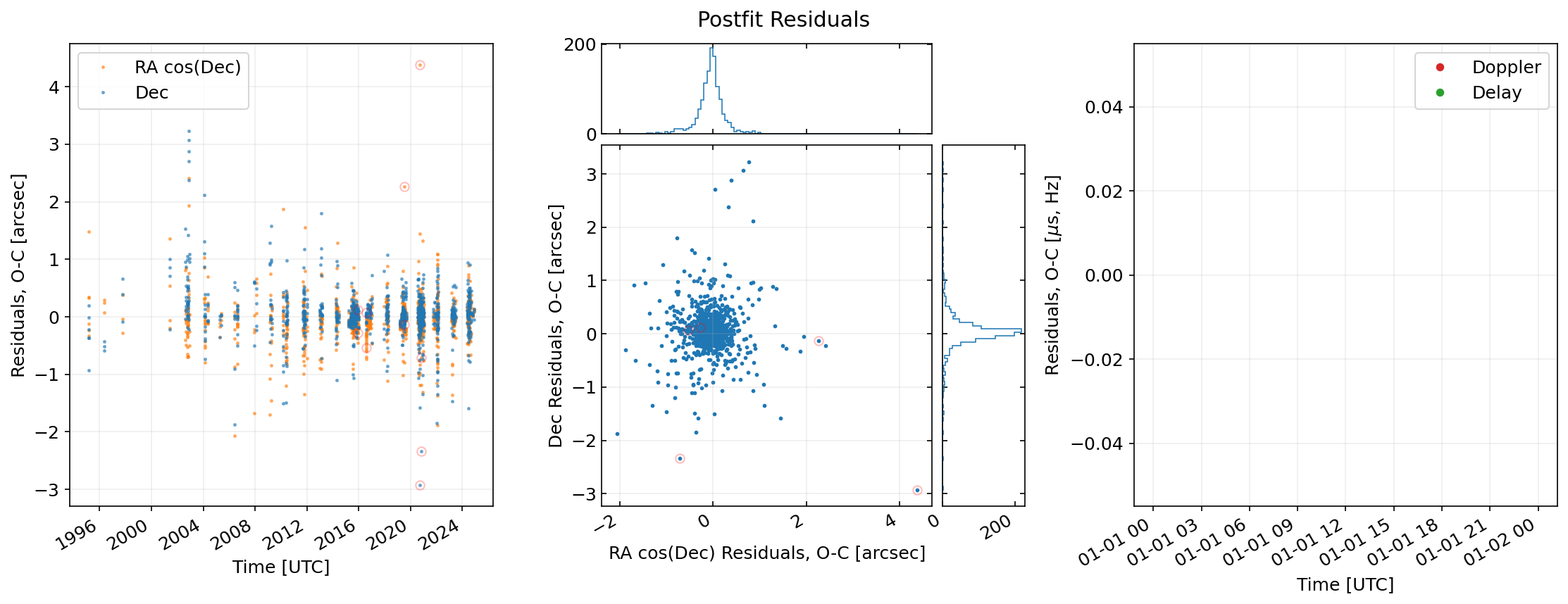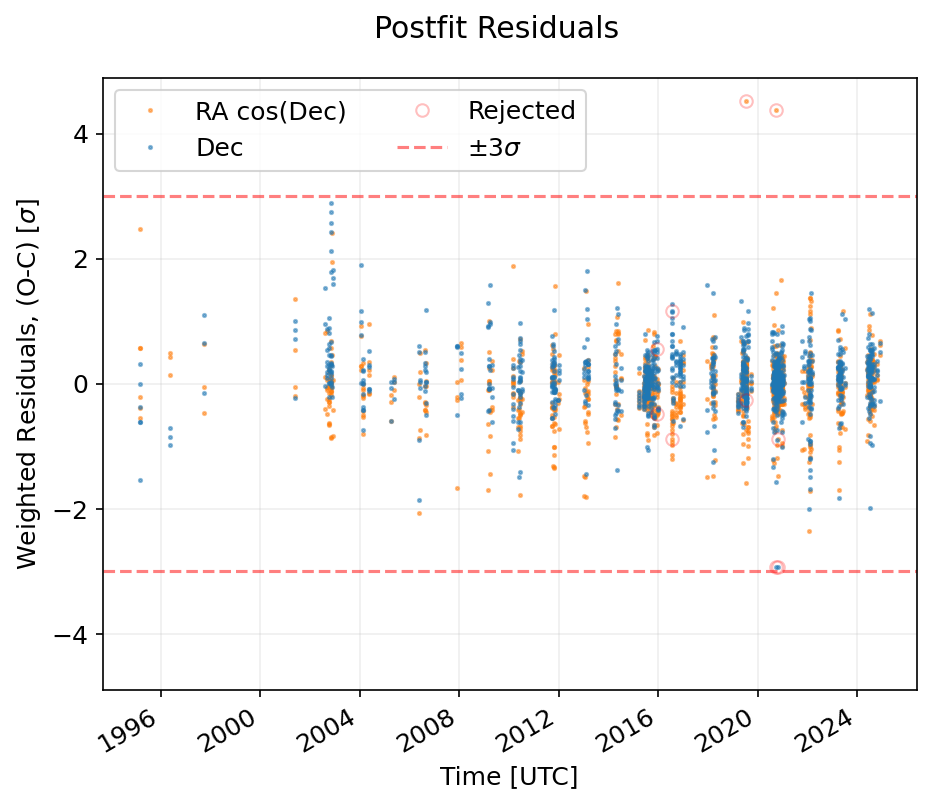(84100) Farnocchia orbit determination test#
Let’s start by importing the necessary libraries#
[1]:
from grss import fit
import numpy as np
np.set_printoptions(precision=40, linewidth=np.inf)
We’ll then retrieve the cometary state of the asteroid (from JPL SBDB) plus any nongravitational accelerations acting on it.#
[2]:
body_id = '84100'
init_sol, init_cov, nongrav_info = fit.get_sbdb_info(body_id)
de_kernel = 440
Next, we’ll retrieve the observations from different sources (MPC, JPL, Gaia Data Releases) and prepare them for the orbit determination process.#
[3]:
add_gaia_obs = True
optical_obs_file = None
t_min_tdb = None
t_max_tdb = None
debias_lowres = True
deweight = True
eliminate = False
num_obs_per_night = 4
verbose = True
obs_df = fit.get_optical_obs(body_id, optical_obs_file, t_min_tdb, t_max_tdb, debias_lowres, deweight, eliminate, num_obs_per_night, verbose)
obs_df = fit.add_radar_obs(obs_df, t_min_tdb, t_max_tdb, verbose)
if add_gaia_obs:
gaia_dr = 'gaiafpr'
obs_df = fit.add_gaia_obs(obs_df, t_min_tdb, t_max_tdb, gaia_dr, verbose)
Read in 1066 observations from the MPC.
Filtered to 1066 observations that satisfy the time range and accepted observatory constraints.
Applying Eggl et al. (2020) debiasing scheme to the observations.
Unknown star catalog: UNK
No debiasing needed for 628 observations.
Debiased 416 observations.
No bias information for 22 observations.
Applying Vereš et al. (2017) weighting scheme to the observations.
Using 928 CCD observations with station-specific weight rules.
Applying sqrt(N/4) deweighting scheme.
Deweighted 165 observations.
Read in 191 Gaia observations from gaiafpr
Filtered to 191 observations that satisfy the time range constraints.
All we need to do now is initialize the OD simulation and run the filter.#
[4]:
n_iter_max = 10
fit_sim = fit.FitSimulation(init_sol, obs_df, init_cov, n_iter_max=n_iter_max, de_kernel=de_kernel, nongrav_info=nongrav_info)
[5]:
fit_sim.filter_lsq()
Iteration Unweighted RMS Weighted RMS Chi-squared Reduced Chi-squared
1 0.390 0.561 791.001 0.315
2 0.390 0.561 790.489 0.315
Converged without rejecting outliers. Starting outlier rejection now...
3 0.370 0.532 711.478 0.285
4 0.369 0.532 710.705 0.285
Converged after rejecting outliers. Rejected 5 out of 1257 optical observations.
Let’s print some summary statistics and plot some results.#
[6]:
fit_sim.print_summary()
Summary of the orbit fit calculations after postfit pass:
==============================================================
RMS unweighted: 0.369456547326613
RMS weighted: 0.531694378992771
chi-squared: 710.7050664084062
reduced chi-squared: 0.2845096342707791
square root of reduced chi-squared: 0.5333944452942673
--------------------------------------------------------------
Solution Time: MJD 58293.000 TDB = 2018-06-24 00:00:00.000 TDB
Solution Observation Arc: 10856.90 days (29.72 years)
--------------------------------------------------------------
Fitted Variable Initial Value Uncertainty Fitted Value Uncertainty Change Change (sigma)
e 2.02454518255e-01 1.40679721887e-09 2.02454518327e-01 1.41317622181e-09 +7.17414183615e-11 +0.051
q 2.17771395357e+00 4.95647771455e-09 2.17771395474e+00 4.98668875415e-09 +1.16643006365e-09 +0.234
tp 5.90657522397e+04 1.11963525625e-05 5.90657522435e+04 1.12633536767e-05 +3.77366814064e-06 +0.335
om 1.52352438968e+02 1.14823095924e-06 1.52352438972e+02 1.16994806898e-06 +4.56003590443e-09 +0.004
w 2.08317637638e+02 2.29596260037e-06 2.08317638239e+02 2.31128284444e-06 +6.01586719995e-07 +0.260
i 5.81734038604e+00 1.28497749429e-07 5.81734041366e+00 1.29258963746e-07 +2.76243286024e-08 +0.214
[7]:
fit_sim.plot_summary(auto_close=True)

[8]:
fit_sim.iters[-1].plot_iteration_summary(title='Postfit Residuals', auto_close=True)


[9]:
mean_0 = np.array(list(init_sol.values())[1:])
cov_0 = init_cov
mean_f = np.array(list(fit_sim.x_nom.values()))
cov_f = fit_sim.covariance
maha_dist_f, maha_dist_0, bhattacharya, bhatt_coeff = fit.get_similarity_stats(mean_0, cov_0, mean_f, cov_f)
print(f'Mahalonobis distance between JPL and GRSS solution: {maha_dist_f:0.2f}')
print(f'Mahalonobis distance between GRSS and JPL solution: {maha_dist_0:0.2f}')
print(f'Bhattacharya distance between JPL and GRSS solution: {bhattacharya:0.4f}')
print(f'Bhattacharya coefficient between JPL and GRSS solution: {bhatt_coeff:0.4f}')
Mahalonobis distance between JPL and GRSS solution: 0.36
Mahalonobis distance between GRSS and JPL solution: 0.36
Bhattacharya distance between JPL and GRSS solution: 0.0003
Bhattacharya coefficient between JPL and GRSS solution: 0.9997
Finally, we’ll make sure the GRSS solution is statistically consistent with the JPL SBDB solution#
[10]:
assert maha_dist_f < 5.0
assert maha_dist_0 < 5.0
assert bhattacharya < 0.10
assert bhatt_coeff > 0.90
[ ]: